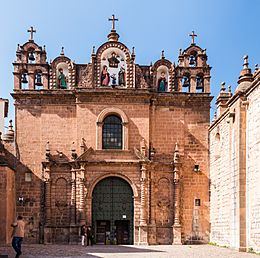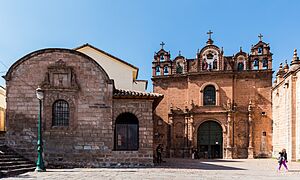Templo de la Sagrada Familia, Cusco facts for kids
Quick facts for kids Templo de la Sagrada Familia |
|
|---|---|

Main facade
|
|
| Location | Cusco |
| Country | Peru |
| Denomination | Roman Catholic |
| Architecture | |
| Style | Renaissance |
| Groundbreaking | 1723 |
| Completed | 1735 |
The Templo de la Sagrada Familia is a beautiful church in the city of Cusco, Peru. It is also known as the Temple of Jesus, Mary, and Joseph. This church was built in the Renaissance style. A famous architect named Francisco Becerra designed it.
Contents
History of the Church
Building the Temple
The construction of the Templo de la Sagrada Familia began on September 13, 1723. Bishop Gabriel de Arregui ordered its creation. The church was built following the plans made by Francisco Becerra.
After the first architect passed away, the work on the church paused. It started again in 1733. The building was finally finished on September 3, 1735.
Restoration Work
The church was closed for about 30 years. In 1996, it received help to be restored. The Archbishopric of Cusco and the European Union supported this important project. Thanks to their efforts, the temple was brought back to its original beauty.
What the Temple Looks Like
Church Design and Materials
The Templo de la Sagrada Familia has a special shape called a Latin cross. This means it has a long main part and shorter arms on the sides. The inside walls are made of smooth stone covered with lime plaster. The entire church is built using andesite, a strong type of rock.
The roof of the temple has five arched sections called vaults. These vaults are made from rectangular bricks. At the front of the church, where the altar is, there is a beautiful altarpiece. This is a large, decorated screen behind the altar.
Inside the Temple
The altarpiece inside the church is made of cedar wood. It was created in 1737. It is carved with many details and covered in gold. This altarpiece holds old statues and paintings. There is also a lovely silver front, a tabernacle (a special box for sacred items), and racks, all very well made.
In 1745, a generous person named José Pardo de Figueroa donated many valuable items. These included a silver front, special cloths, candle holders, a silver lamp, and a crystal lamp.
Art and Paintings
The church also features amazing paintings by a talented Indigenous artist named Antonio Sinchi Roca. His paintings include The Eucharist, The Penance, and The Baptism. These artworks might have been part of a larger series about the Christian Sacraments. You can also find a portrait of Bishop Gabriel de Arregui inside. He was the bishop who started the church's construction.
See also
 In Spanish: Iglesia de Jesús, María y José (Cuzco) para niños
In Spanish: Iglesia de Jesús, María y José (Cuzco) para niños


